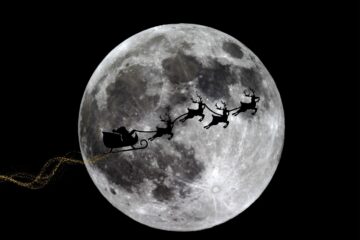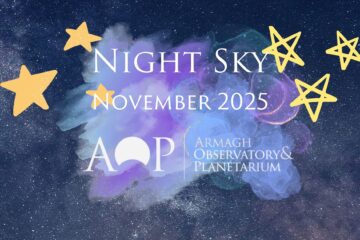Autumn is well and truly settled in and we are in the ‘Hallowed’ month of October so many exciting things grace our sky!This month we can try and see what spooky sightings usually turn out to be, as well as some frightful objects that roam the October sky!The longer dark nights are perfect for trying to spot these spooky wonders but wrap up in your woollies because it will be quite chilly.So let’s delve in and see if any of our stellar terrors are too frightening to witness!

M42 Orion Nebula (M42) showing complete nebulous complex, including M43, and the combined emission/reflection nebulous complex consisting of NGC 1973, NGC 1975, NGC 1977 (left of frame).(Image credit:Wikimedia.org)
Now the autumn sky brings some of the most loved and familiar constellations back to the forefront so let’s welcome them back by spending some time discovering what lurks in their shadows.
So let’s begin by gazing south east around the ‘hallowed’ hour of midnight in the middle of the month and just slightly up from the horizon you should spot the proud hunter Orion by his bright three-starred belt.Orion has many myths that have formulated over the years, one such story is that he was the son of Neptune, the sea god, and the great huntress Queen Euryale of the Amazons. Inheriting his mother skills and strengths he went on to boast he could kill any animal in the world, until a scorpion, after hearing this vain boast, stung and killed him and both were placed into the heavenly sky but at opposite ends as to never see them together. Well pride is often a scary trait and can lead to terrifying end in the stellar stories of the night sky but Orion has many frightening residents so let’s see what we can find. Orion itself has more bright stars visible to the naked eye compared to any of the other constellations. So it’s a very easy pattern to spot, especially as his belt is so distinctive but once you find the hunters belt notice the celestial sword handing from it and follow it down until you notice a smudge of light in the sky to the left of the sword. Your eyes will be resting on the magnificent Great Orion Nebula or M42. Perhaps one of the most famous nebulae with an apparent magnitude of 4.0, it is the closest region of massive star formation to the Earth only being 1344 light years away. But like all those who command any fame it appears to have a stalker in the night sky, a ghostly stalker and this is what we are more interested in. It is the Ghost Nebula or NGC 1973, 1975 and 1977. This smaller nebula is lurking to the left of the Great Orion nebula and appears to be a shimmering ghostly figure. It is a reflection nebula so the stars surrounding it are what lights up this eerie figure. This nebula is more widely known as the ‘Running Man Nebula” but few had taken to renaming it and I’m not sure about you but this nebula has more of a resemblance to Casper than Usain Bolt!
Our next spooky spectacle is not too far away as its hiding around the right foot of Orion, at the bright blue supergiant star of Rigel shining like a torch in the dark, and this stellar torch lights up a mischievously secret nebula, IC2118 or the Witch Head Nebula! This is a reflection nebula which basically is dark dust and gas that is lit up by a nearby star or stars; in this case it illuminated a mystic blue by the luminous Rigel which shines with a magnitude of 0.1 and is 66,000 times more luminous than our Sun so no wonder this creepy crone couldn’t hide! Its bluish colour is obviously due to the colour of Rigel but also similar to the process that causes our sky to be blue because the dust in the nebula reflects blue light more efficiently.This object is very difficult to spot in the night sky without a strong telescope but you can look up in wonder that this stellar witch is flying above.
Now every witch is not complete without her feline familiar and the sky does not disappoint.The feline spectacle is located with a celestial monster in the sky, Draco the Dragon, one of the six circumpolar constellations. Draco himself is a terrifying spectacle and to find him, first search for the North Star or Polaris located at the end of Ursa minors tail in the Northern Sky. Once you spot it move at an angle moving down to the west until your North West in the sky and you will be around the neck of Draco. And hidden behind the dim scaly monster is an eye watching your every move. You will need a telescope to see this object but it is well worth it, it’s the Cat’s Eye Nebula or NGC 6543. With a magnitude of 9.8 it is tough to spot but this very complex nebula has much to offer.This ever seeing eye has many shapes surrounding an extremely hot star that lost its outer layer about 1000 years ago to reveal this spooky feline’s eyeball!

The Galactic Ghoul:if this was just a few light years away it would fill the night sky.What sort of myths and religions would it have inspired? (Image credit:Wikimedia.org)
Now the last spooky object is located in Cygnus the Swan is perhaps the creepiest of all although it is fairly hidden with NASA’s Spitzer Space Telescope revealing this hidden monster. It is the Nebula DR 6or the ‘Galactic Ghoul’. This cluster contains dust gas and roughly 10 large new-born stars that are nearly 20 times bigger than our Sun and together they span about 3.5 light years across. It’s a particularly creepy object due to the shape of the bust appearing to be two massive sunken holes for eyes and a huge screaming mouth! This particular nebula nasty was even used by NASA as their Astronomy Picture of the Day on All Hallows Eve in November 2004.

An Iridium satellite:did anyone guess before they were launched, just how spectacular they would appear? (Image credit:Wikimedia.org)
Now let’s address a popular misconception that the spooky goings on only happen at night when daytime has its own frightening occurrences.
There have been many reported sightings of strange brief streaks of light on a clear day, even videos captured of these unofficial ‘UFO’ sightings.But are we being continuously visited by extra-terrestrials and Barney and Betty Hill are just a tad crazy? In essence no, it’s not movies come to life but rather a glimpse at how we can use modern communications every day! There are 65 Iridium Satellites in orbit around the Earth and this large group of satellites provide the coverage of voice and data to satellite phones, pagers and integrated transceivers over Earth’s entire surface! The satellites themselves have a very strange shape with three polished door sized antennae which cause satellite flares, some of which are so bright you can see them during the day. Satellite flares are basically caused by reflective surfaces on satellites which bounce the sunlight down to us here on Earth and appear as a brief, bright flare in the sky (see the video linked to below). Now not all of these are the Iridium satellites but due to the amount of them it most often will be.So alas no little green men are coming down to celebrate Halloween with us but then again never say never!
So let’s move on to talk about the spooky full moon in October and whilst many cultures and beliefs revere the Moon in different way and methods, for stargazers it’s an absolute beauty to behold.The Full Moon falls on 29 October and will be high up in the sky in the constellation of Pisces the Fish, in the south.Referred to in the
Almanac as the Hunters’ Moon as this was the time of year that the leaves had fallen and the game was fattened and you prepared for the onset of winter. But other myths are much more scary so fingers crossed for a quiet full moon and hopefully you will hear no howling whilst gazing up at the celestial stunner.
The October sky has much to offer and a darker sky to give more chance of seeing those harder to spot objects but remember to wrap up warm and perhaps pack some garlic or silver with your telescope, just in case!
Happy Halloween everyone from Armagh Planetarium!
(Article by Kerry Scullion, Education Support Officer)






1 Comment
Erwin Rosheuvel · September 4, 2015 at 17:40
Great photos!